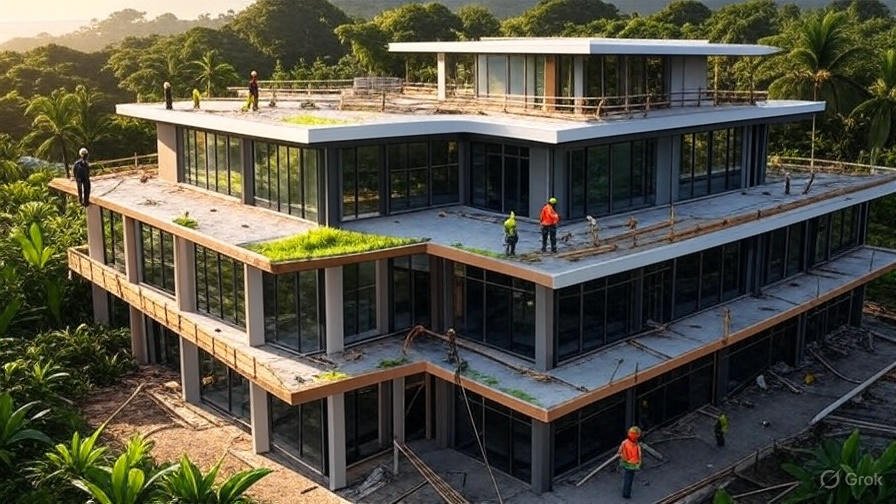A Booming Market Driven by Tourism and Investment
The commercial construction industry in Costa Rica has seen steady growth, particularly in regions like Guanacaste and the Central Valley. According to a 2013 report by the National Institute of Census and Statistics (INEC), commercial construction in Guanacaste alone expanded by nearly 20% in the first half of that year, a trend that has continued in subsequent years. This growth is largely fueled by the tourism sector, which demands modern facilities such as hotels, resorts, and mixed-use developments to cater to an influx of international visitors. Areas like Tamarindo, Playa Flamingo, and Dominical have become hotspots for such projects, with developers focusing on high-end, sustainable designs that appeal to eco-conscious travelers.
Foreign investment has also played a pivotal role. The Costa Rican government’s favorable policies, including tax incentives and streamlined permitting processes for certain projects, have attracted international developers and businesses. For instance, the Public Works Concession Law enables large-scale infrastructure projects through public-private partnerships, creating opportunities for commercial developments like shopping centers, office buildings, and logistics hubs. These projects not only stimulate economic growth but also create jobs, further boosting local economies in areas like Pérez Zeledón and the southern zone.
Adapting to Costa Rica’s Unique Challenges
Building in Costa Rica presents distinct challenges due to its seismic activity, tropical climate, and environmental regulations. The country lies in a seismically active region, necessitating robust building codes to ensure structures can withstand earthquakes. The Commercial Construction in Costa Rica sector relies heavily on reinforced concrete, which offers durability and flexibility to endure seismic events. Concrete block construction, often reinforced with steel rebar, remains a popular choice for commercial buildings due to its strength and resistance to the heavy rains and high humidity of the tropical climate.
Moreover, Costa Rica’s commitment to environmental sustainability shapes construction practices. Developers are increasingly incorporating eco-friendly materials and energy-efficient designs to align with the country’s goal of becoming carbon-neutral. For example, firms like Arkcon de Costa Rica emphasize sustainable construction techniques, using premium materials and advanced methods tailored to the climatic and geographic conditions of areas like Dominical. These practices not only reduce environmental impact but also appeal to a growing market of eco-conscious investors and consumers.
Innovative Construction Methods Gaining Traction
The commercial construction landscape in Costa Rica is also witnessing a shift toward innovative building methods. Steel-frame construction, for instance, is gaining popularity for its flexibility and earthquake resistance. Unlike traditional concrete block construction, steel frames allow for easier renovations and maintenance, making them ideal for dynamic commercial spaces like office buildings and retail centers. Additionally, prefabricated materials, such as those used in the MKS system by ByM Constructions, offer seismic resistance, thermal insulation, and design flexibility, with costs starting at approximately $100 per square foot.
Another trend is the integration of modern design elements that enhance functionality and aesthetics. High ceilings, for example, are becoming a staple in commercial projects, particularly in hospitality developments. They provide natural ventilation, reducing reliance on air conditioning in Costa Rica’s warm climate, and create a sense of spaciousness that appeals to high-end clients. Similarly, sliding glass doors and bi-folding doors are increasingly used to blur the lines between indoor and outdoor spaces, a feature that resonates with the country’s emphasis on connecting with nature.
Navigating Regulatory and Logistical Hurdles
Despite the opportunities, commercial construction in Costa Rica is not without its challenges. The permitting process, while structured, can be time-consuming. Developers must submit detailed plans to the National Institute of Housing and Urbanism (INVU) and local municipalities, ensuring compliance with strict building codes and environmental regulations. The process requires collaboration with certified architects and engineers from the Costa Rican Colegio of Engineers and Architects, adding a layer of complexity to project planning.
Labor and material costs also pose challenges. While labor is relatively affordable compared to developed nations, the cost of importing high-quality materials can drive up expenses. Additionally, unpredictable weather, particularly during the rainy season, can delay projects, as seen in cases where road construction and other infrastructure projects faced setbacks due to mudslides and flooding. Developers must plan meticulously to account for these factors, often working with experienced local firms to navigate logistical hurdles.
Opportunities for Growth and Collaboration
The future of commercial construction in Costa Rica looks promising, with opportunities for both local and international players. The annual Expo-Construcción trade fair, held in mid-February, serves as a platform for U.S. and global companies to showcase construction equipment and technologies, fostering collaboration and innovation. The U.S. Commercial Service in Costa Rica supports these efforts through initiatives like the Deal Team, which connects American firms with local partners and provides market intelligence for infrastructure projects.
Furthermore, the rise of mixed-use developments is reshaping the commercial landscape. Properties like Sueños de Mariposa in Lagunas, which combine commercial spaces with residential units, highlight the potential for high-return investments. These projects cater to the growing demand for integrated spaces that offer convenience and luxury, particularly in tourist-heavy areas like Playa Hermosa and Santa Teresa.
Conclusion: A Sector Poised for Expansion
As Costa Rica continues to grow as a destination for tourism and business, the commercial construction sector is poised for further expansion. By embracing sustainable practices, innovative materials, and modern design trends, developers are meeting the demands of a dynamic market while respecting the country’s environmental ethos. For those looking to invest or build, partnering with experienced firms like those at Commercial Construction in Costa Rica can ensure projects are completed with quality and efficiency, contributing to the nation’s economic and cultural vibrancy.
With its blend of natural beauty, economic potential, and a commitment to sustainability, Costa Rica’s commercial construction industry is not just building structures—it’s building the future of a nation that continues to captivate the world.
